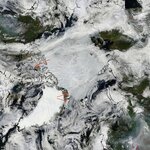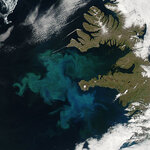Oceanography

Arctic Ice August 2010 - Update #1
Most of the fires in Siberia seem to have been put out or burned out. Meanwhile, the fires near Moscow continue to burn and there are more fires in Alaska. I have made a mosaic composite showing the fires at the time of writing. I have enhanced some of the red fire markers where they were faint in the MODIS originals. Please note that the size of a red blob does not equate to the size of the fire.
The Arctic - August 04-05 2010 - approx. 2km resolution.
There are three red arrows pointing to the North West Passage and two sheets of…

Arctic Ice August 2010
Arctic warming and global warming.
The year up to July 31 has produced many examples of anomalous weather events globally. We have seen fires, floods, droughts and sandstorms on an immense scale. A new report shows that 10 out of 10 indicators of global warming are trending in the direction predicted when global warming was merely a theory, rather than a self-evident fact.
Global warming means that more heat is being trapped in our atmosphere and oceans. To cope with the excess of thermal energy the planet's atmospheric and ocean circulation systems…

Arctic Ice July - Update #5
The sharp decline in ice extent slowed somewhat during July. Some people are claiming this as a sign of recovery.
If you are going downhill at full throttle and you take your foot off the gas you will slow down. A bit. But if the brakes aren't working you are in for an exciting time.
Loss of ice extent has slowed down. A bit. In plain language: loss of ice continues to be a lot more rapid than has been considered normal historically.
Almost the entirety of the main Arctic Ocean ice cover shows substantial amounts of open water. …

Biotransport and ocean mixing
Before I get into the 'bio' aspect of this article I want to put it in context by pointing to a means of ocean mixing that is not as well known as it deserves to be. And to put that, in turn, in context: a new report from NSIDC confirms that there is a lot of open water in the central pack near the North Pole. That open water was noted by one of my readers, Lord Soth in a comment.
Here is an abstract from the NSIDC report for July 20 2010:
While we normally report on the extent of area covered by at least fifteen percent sea ice, a more reliable…

Arctic Ice July 2010 - Update #3
An update and a bit of Arctic history.
Despite the extensive cloud cover over much of the Arctic it is possible to see some interesting patterns of behavior.
Around the Siberian side of the Arctic the ice has already retreated from shore or is in process of retreating. The same goes for the Alaskan and Canadian shores as far as Prince Patrick Island. Ice in the fjords and passages from the Beaufort Sea to Nares Strait is melting.
From Prince Patrick Island to the Nares Strait, ice is being pressed inshore. Ice is also pressed inshore from…

Arctic Ice July 2010 - Update #2
Something strange is going on. Arctic watcher blogs are abuzz with talk about the behaviour of graphics which are supposed to show ice extent, area or volume. many of these graphics seem to show that the Arctic melt has stopped. Which it hasn't.
Historically, the main pack was always thick multi-year ice. Ice would be lost at the edges in summer, and the new winter ice would be pressed into the main pack by the various drift motions. As ice motion opened a new lead it would rapidly freeze over - even in summer. As the ice…

Arctic Ice July 2010 - Update #1
Before I write another line about ice, I want to thank all of my readers. Whether or not you leave comments, whether or not you link in other blogs, just knowing that I have so many readers gives me the encouragement to keep going: to keep up the standards I have set myself.
One of the standards I set for myself is to always remember just how much I don't know. We have much still to learn about the Arctic. Just when we think we know all there is to know, you can be sure that nature will remind us most harshly of our blind ignorance.
Arctic…

We've all heard all about how the ice sheets (Greenland, Antarctica, glaciers) melting will result in sea level rise. One could easily believe that it is a one-to-one correlation between diminishing ice sheets and rising sea level. It is a tad more complicated, I'm afraid.
Relax, I'll spare you the ugly details. I will however share a couple of perspectives on the issue.

Polar science will continue to have a global impact, whether you believe in man-made climate change or not, says an expert.
Global warming was always an unfortunate use of 'framing' by policy-oriented scientists who were out of their league and political groups looking to mobilize their base. Climate change was always the issue and change can mean warming ... which leads to cooling.
For example, a warmer Arctic climate influences air pressure at the North Pole and shifts wind patterns, meaning warming results in more cold and snowy winters in Europe, eastern Asia and eastern North…

A 'message in a bottle' has been a mainstay for romantics throughout the centuries - sure, putting up an old picture on the Internet is a faster way to meet new people now but there is something poignant about the randomness of nature coupled with an intentional act of bridging distances, though these days you'll have Greenpeace ramming your ship if you try it - unless it's for science.
Global warming is melting ice in the Arctic and that means more cold water entering the oceans. How it will affect ocean currents is unknown, numerical models of chaos being pretty useless, but there is…